Anja and Acadia von Ravenfeld @ 6 months old
out of
Raven dei Precision x Vandal vom Mittelwest
and German Shepherd Dogs
There are a lot of misconceptions about protection sports and training for dogs. I am going to talk about a couple of the ones I hear most, which are “Protection training is abusive” and “Protection dogs are aggressive”. For sake of this article, I am speaking about those who responsibly train dogs with the correct temperament for protection training, which I feel is the majority. I’ve worked with many dogs and people in protection training and have a broad understanding of this type of training. There are people in every aspect of life that can do things wrong and give an entire cause a bad rep. I’m not talking about those few.
Myth: protection training is forceful and abusive. NO! Not at all. Properly training a dog to bite requires absolutely no force whatsoever. We don’t force our dogs or intimidate them to get them to bite. We encourage, motivate, and utilize their innate drives to teach them to bite. Keep in mind, most dogs that are trained for protection sports, are usually bred for it and actually require very little to activate their prey instincts to encourage a bite. We may frustrate them to encourage a bark or bite, but no more frustration than Sparky the terrier gets when watching rabbits play in the front yard all day through the living room window. By no means is this abusive. They love the training, like a Lab loves to retrieve; a dog bred for protection work loves to bite. 
But… what about the stick they hit the dog with?? The stick in schutzhund is padded, and does not at all hurt the dog. Not a bit. The stick hits are not done with any force either. The stick hits are to test a dog’s response to a (perceived) threat or pressure, not to hurt the dog.
Myth: schutzhund/protection trained dogs are mean and aggressive towards all people. Again, nope. I’ve never met a protection trained dog that was dangerous to have in public settings. First, no dog should ever be trained in protection that has a questionable temperament. Bad temperament is genetic, and is what makes a dog mean and aggressive. Protection training does not make a dog mean and aggressive. Second, protection trained dogs are trained very highly in obedience as well as protection. I trust them more than Joe Schmoe at the park with his off leash Chihuahuas running up to me barking as he shouts “They’re friendly”. I can take my schutzhund dogs anywhere without 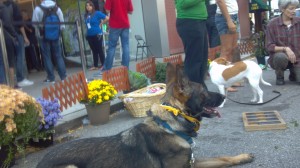 worrying at all, around any person, young, old, big, small, black, white, with a hat, without a hat.
worrying at all, around any person, young, old, big, small, black, white, with a hat, without a hat.
If I still haven’t convinced you, then get to your local reputable schutzhund or dog sport club and see them working. Seeing is believing, right?

It’s that time of year already! While many dogs love the cold weather and playing in the snow, there are a few things to prepare and lookout for that come along with the snow and cold temperatures.
1. Wintertime can be hard on your dog’s paws. They are susceptible to drying, cracking, frostbite, and chemical burns (salt). There are many protective balms available to help avoid these issues. Musher’s Secret (http://musherssecret.net/) is my favorite; you can apply it directly on your dog’s paws to help protect them.
Boots are another good protective option for your dog’s paws. Keep in mind they might dislike them at first, but *usually* they get used to them and don’t mind wearing them around. I personally find the balm easier to use, but some people swear by their dog’s booties!
Keep the hair on the underside of your dog’s paw trimmed in the winter, to prevent ice balls from forming around the pads. Some dogs don’t grow excess hair underneath their paws, so you don’t have to worry about it.
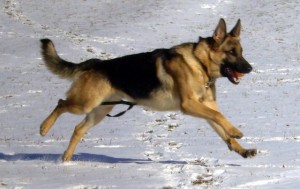 Buy a pet friendly ice melt for use on your sidewalks and driveway at home! Many de-icers are toxic. If you can avoid walking on roads and sidewalks treated with salt, do so. If not, make sure you always wipe off your dog’s paws with warm water after a walk. Discourage your dog from eating snow near roads and sidewalks that have been treated with salt.
Buy a pet friendly ice melt for use on your sidewalks and driveway at home! Many de-icers are toxic. If you can avoid walking on roads and sidewalks treated with salt, do so. If not, make sure you always wipe off your dog’s paws with warm water after a walk. Discourage your dog from eating snow near roads and sidewalks that have been treated with salt.
If you notice your dog holding their paws up off the ground abnormally at any time while on a walk or playing in the snow, time to call it and head back inside!
2. Anti-freeze is very toxic and there is a high mortality rate when ingested. The sweet smell attracts dogs. If you use anti-freeze, lock it away in a vault after use. There are alternatives to anti-freeze also (propylene glycol). If you suspect in the slightest your dog could have ingested anti-freeze, get to the vet immediately!
3. Arthritis tends to be worse in cold weather. If you notice your dog become stiff, or taking longer to get up and down, you might want to have an x-ray done to determine if it is due to arthritis. There are many things you can do to help ease the pain from arthritis in your dog. Moderate exercise, weight control, supplements, acupuncture are just a few.
4. Be careful not to let your d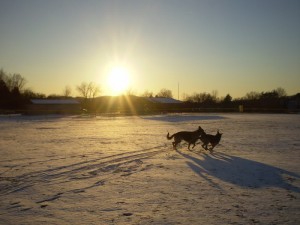 og run on any icy spots. They can twist or sprain a muscle, or break a bone if they run and slip on ice the wrong way! If it is an icy day, be very careful!! Dogs also don’t realize what thin ice is. Be careful around frozen lakes, or ponds! Training your dog to walk on a loose leash is important all year round, but especially in the wintertime when you don’t want your dog pulling you around on the snow and ice.
og run on any icy spots. They can twist or sprain a muscle, or break a bone if they run and slip on ice the wrong way! If it is an icy day, be very careful!! Dogs also don’t realize what thin ice is. Be careful around frozen lakes, or ponds! Training your dog to walk on a loose leash is important all year round, but especially in the wintertime when you don’t want your dog pulling you around on the snow and ice.
5. For small dogs, or dogs with a short, tight or single layer coat, be careful having them outside for too long of a period at a time. Sweaters can be very important for some breeds of dogs. If your dog is shivering, time to head back inside! If your dog is small, and the snow accumulation is taller than them, you will have to shovel out a pathway or potty and play area for them outside.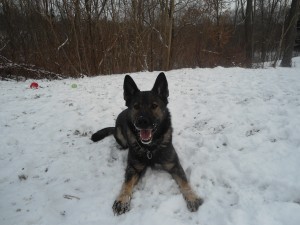
6. Fireplaces and space heaters can be attractive to some dogs, make sure that they don’t lie too close to these and get burned! All fireplaces should have a grate or a door of some sort. Be careful your dog doesn’t knock over a space heater, which could be a fire hazard for the entire household. Never leave a space heater on with a dog around unsupervised!
Keep these things in mind when you head outside with Fido to play a game of snowball fetch!
I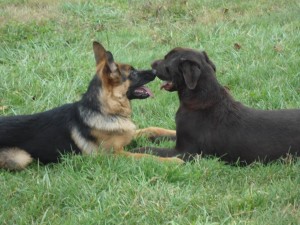 n short, no! Dogs do not NEED to play with other dogs. However, with the right match ups, and the right setting, it can be enjoyable for your dog to romp with other canine pals. Nothing beats watching dogs play with each other, rolling, biting, running, jumping. We just can’t play with our dogs the way they play with each other.
n short, no! Dogs do not NEED to play with other dogs. However, with the right match ups, and the right setting, it can be enjoyable for your dog to romp with other canine pals. Nothing beats watching dogs play with each other, rolling, biting, running, jumping. We just can’t play with our dogs the way they play with each other.
When and where should you let your dog play with other dogs?
I’m personally not a fan of dog parks. I’ve seen too many fights, and for some dogs, one fight is all it takes to forever make them reactive or unsure of other dogs. I know realistically for some dog owners, especially city dwellers, the dog park is the best way to exercise Fido. Many dogs go to the dog park every day and never have an issue. The key is being aware, not only of your own dog, but to the other dogs at the park.
It only takes a second for a fight to break out, but if you are being attentive, the dogs will usually give signs that there i s a potential mis-match of personalities which could lead to a squabble. The first squabble might be worked out with a growl and a snap and then everything is okay again, the next one might not be so mild. It’s a fine line between letting the dogs work it out on their own, or removing your dog from the group. Many times letting the dogs work it out on their own is the right thing to do, sometimes it’s not, and if you don’t have an experienced eye for reading canine body language I would recommend erring on the side of caution and taking your dog away if there is a continuous issue. If you sense your dog is being pestered, or pestering, do everyone a favor, and take Fido home for the day. Unfortunately, the biggest problem I’ve seen at dog parks, are those people not paying attention to their dogs, and not taking their dog away before a fight breaks out even though there were plenty of signs there to warn them. Some dogs are just not dog park type dogs, and that is okay, it doesn’t make your dog a bad dog. It also does not mean that they can’t have a few dog friends that they play with elsewhere.
s a potential mis-match of personalities which could lead to a squabble. The first squabble might be worked out with a growl and a snap and then everything is okay again, the next one might not be so mild. It’s a fine line between letting the dogs work it out on their own, or removing your dog from the group. Many times letting the dogs work it out on their own is the right thing to do, sometimes it’s not, and if you don’t have an experienced eye for reading canine body language I would recommend erring on the side of caution and taking your dog away if there is a continuous issue. If you sense your dog is being pestered, or pestering, do everyone a favor, and take Fido home for the day. Unfortunately, the biggest problem I’ve seen at dog parks, are those people not paying attention to their dogs, and not taking their dog away before a fight breaks out even though there were plenty of signs there to warn them. Some dogs are just not dog park type dogs, and that is okay, it doesn’t make your dog a bad dog. It also does not mean that they can’t have a few dog friends that they play with elsewhere.
An alternative to the dog park is to set up play dates with friends, neighbors, family member’s dogs, if you know the match-up is right. This can be more enjoyable for all, if you know the dogs, and the people you can relax a little more while Fido and Spot play.
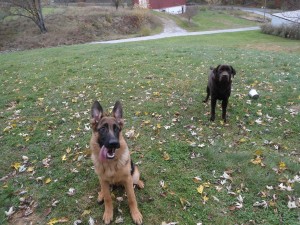 When should you NOT let your dog play with other dogs?
When should you NOT let your dog play with other dogs?
Not when you are on a walk, and pass by another dog. Walks should be just that, walks. If you run into a friend and a dog that your dog is acquainted with, and your friend says it’s okay, then sure, let them greet if you must. If you run into a strange dog your dog doesn’t know, and want to talk to the owner, than have your dog sit next to you while you talk, do not let your dog just run up and greet strange dogs. Some dogs are leash reactive and would not appreciate this. If you are walking on a sidewalk and see another dog approaching, the kind thing to do would to put your dog on the opposite side of you, so you are between the dogs as they pass. They don’t need to sniff noses, or butts as you pass by. The same applies for any public place where you encounter another dog, pet and feed stores, outdoor restaurants, hiking trails, parks (not dog parks), etc. You should never let your dog greet or run up to, or initiate play with any dog without first getting permission from the owner of the other dog.
In a perfect world every dog would have 2 or 3 canine friends that they match up well with and get to see and play with once a week in a private area. If your dog is suited for it, and the dog park is the best you can do, just remember to be aware! All in all, while dog-dog interactions can be great fun and exercise, they are NOT necessary, and Fido would be happy just playing with YOU!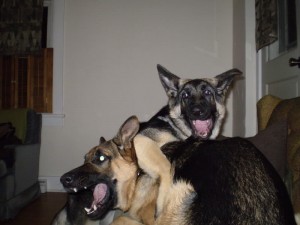
1. It’s fun. For you, and for your dog. Don’t believe me? Give it a try. There is more than just heel, sit, down, and come. Really. Challenge yourself and your dog and commit to trying to teach your dog one new fun trick. Find your keys? Bring the remote? Bring you a beer? There are 100’s of fun tricks you can teach Fido. If you don’t smile when the light bulb finally clicks and your dog “gets it” then, well, I’m sorry, but I bet at least Fido will be happy!
2. Prevent problem behaviors. A dog who knows what is expected of him, is much less likely to do the wrong things. Just by knowing a few simple commands we can show our dogs what we want them to do instead of something we don’t want them to do. For example, by teaching a reliable and rock solid down stay, many problem behaviors can be addressed. Fido can’t jump or dig or bolt out the door if he knows what down & stay is.
3. Mental stimulation. Spending 15 minutes doing a drill of obedience commands, or running through their repertoire of tricks can tire out a dog. Rainy day? Long day at work? Have to skip the walk? Then tire out Fido’s mind instead!
4. Freedom. Training gives your dog freedom and essentially, you as well. Freedom to take your dog with you out and about into the world instead of leaving him at home. Without some basic training however, it might not be fun to take Fido along. Fido needs to know how to walk nice on a leash, not bark at other dogs, sit and stay when asked, and not jump up on strangers. Otherwise a nice trip to the park with Fido can turn into a disaster.
5. Bonding time. Training time is bonding time with you and Fido. When you start to do training with him, you will notice him wanting to do what you ask more and more, rather than wanting to run away from you and play keep away when you call him to come. Fido wants to please, he just isn’t born knowing what you want, so if you teach him what you want, it will help develop a strong bond.